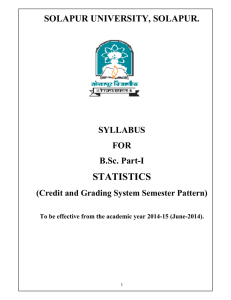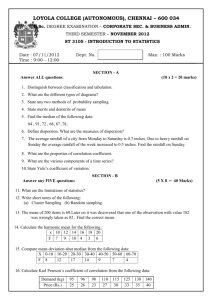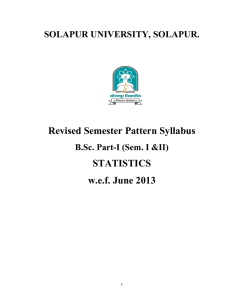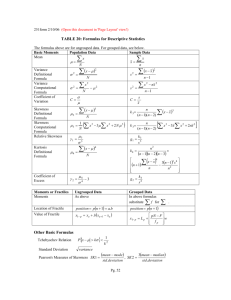STATISTICS (Revised Semester Pattern) SOLAPUR UNIVERSITY, SOLAPUR.
advertisement
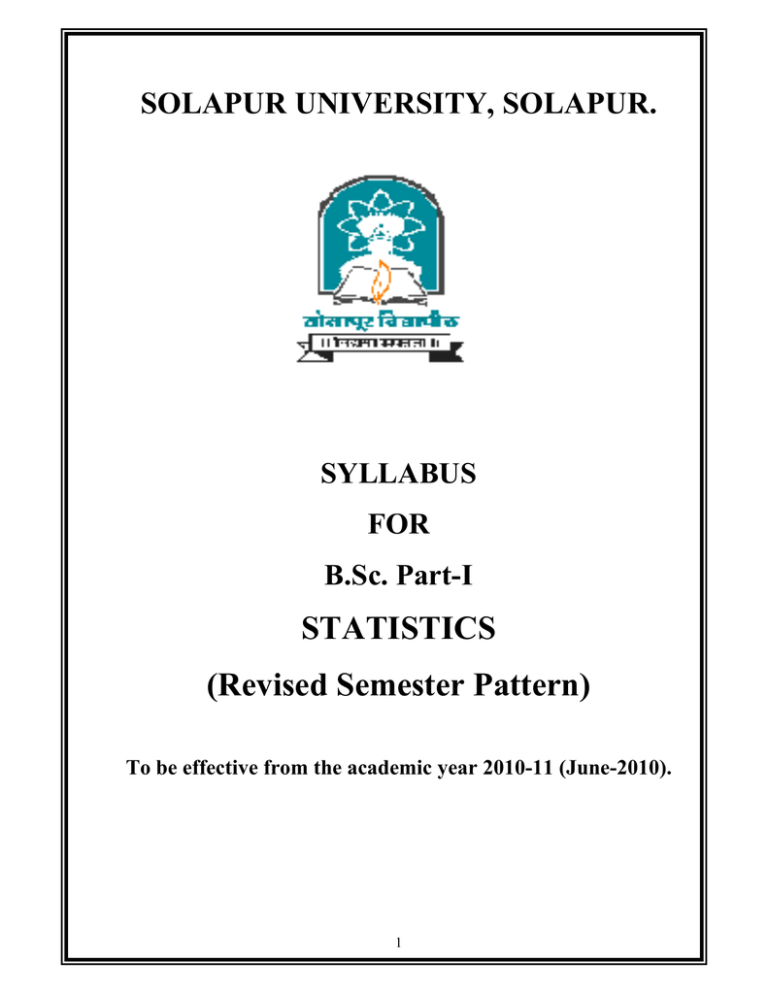
SOLAPUR UNIVERSITY, SOLAPUR. SYLLABUS FOR B.Sc. Part-I STATISTICS (Revised Semester Pattern) To be effective from the academic year 2010-11 (June-2010). 1 SOLAPUR UNIVERSITY, SOLAPUR. B.Sc. Part-I (STATISTICS) Semester Pattern Syllabus (To be implemented from June, 2010) STRUCTURE OF COURSE Semester No. I II ANNUAL EXAM. Paper No. STATISTICS PAPER-I STATISTICS PAPER-II STATISTICS PAPER-III STATISTICS PAPER-IV STATISTICS PRACTICAL Title of the Paper Marks Descriptive Statistics-I 50 Probability and Probability Distributions-I 50 Descriptive Statistics-II 50 Probability and Probability Distributions-II 50 Statistics Practical Paper-I 50 Teaching Periods: 1. Total teaching periods for Two Theory Papers are five periods per week in each semester. 2. Total teaching periods for Practical-I are four periods per week per batch. Duration of examination: 1. For each theory paper of 50 marks two hours. 2. For Practical Paper-I (Four hours for a Batch 20 Students) annually. EQUIVALENCE FOR THEORY PAPERS (From June 2010) Annual Pattern Semester Pattern Paper No. Title of the Paper Paper No. Title of the Paper I Descriptive Statistics-I I Descriptive Statistics III Descriptive Statistics-II II II Probability and Probability Distributions IV 2 Probability and Probability Distributions-I Probability and Probability Distributions-II SEMESTER-I STATISTICS PAPER – I: Descriptive Statistics-I STATISTICS PAPER –II: Probability and Probability Distributions-I Objectives: The main objective of this course is to acquaint students with some basic concerns statistics. They will be introduced to some elementary statistical methods of analysis and Probability at the end of this course students are expected to be able. 1. To prepare frequency distribution and represent it by graphically with the help of tables. 2. To compute various measures of central tendency, dispersion, moments, Skewness, Kurtosis and to interpret them. 3. To distinguish between random and non-random experiments. 4. To find the probabilities of the events. STATISTICS PAPER – I (Descriptive Statistics-I) Unit – 1 (a). Introduction to Statistics : ( 2) 1.1 : Meaning of the word statistics 1.2 : Scope of Statistics : In industry , Biological and Medical Sciences, Economics, Social and Management Sciences. 1.3 : Statistical Organizations in India : CSO, NSS, ISI (Indian Statistical Institute), IIPS (Indian Institute of Population Studies), Bureau of Economics and Statistics, their aims and functions. 1.4 : Indian Statisticians and their contributions. (b). Nature of Data : (7) 1.5 Meaning of primary and secondary data. 1.6 Qualitative data (Attributes) : Nominal Scale and Ordinal scale, Quantitative data (Variables) : Interval Scale and ratio scale, discrete and continuous variables, raw data. 1.7 Classification of data : Discrete and continuous frequency distribution, inclusive and exclusive methods of classification, cumulative frequency distribution, relative frequency. 3 1.8 Graphical representation of data : Histogram, frequency polygon, frequency curve and Ogive curves. 1.9 Illustrative Examples. Unit – 2 Measures of Central Tendency : (10) 2.1 Concept of central tendency of statistical data, statistical average, requirements of good statistical average. 2.2 Arithmetic Mean (A. M.) : Definition, effect of change of origin and scale, deviation of observations from A. M., Mean of pooled data, weighted A. M. 2.3 Geometric Mean (G. M.) : Definition 2.4 Harmonic Mean (H. M.) : Definition 2.5 Relation : A. M. ≥ G. M. ≥ H. M. (Proof for n = 2, positive observations) 2.6 Median : Definition, Derivation of formula for grouped frequency dstribution. 2.7 Mode : Definition for ungrouped and grouped data derivation of formula 2.8 Empirical relation between Mean, Median and Mode 2.9 Partition Values : Quartiles, Deciles and Percentiles 2.10 Graphical method of determination of Median, Mode and Partition values. 2.11 Comparison between averages in accordance with requirements of good average. 2.12 Situations where one kind of average is preferable to others. 2.13 Examples to illustrate the concept. Unit – 3 Measures of Dispersion : (8) 3.1 Concept of dispersion, Absolute and Relative measures of dispersion, Requirements of a good measure of dispersion. 3.2 Range : Definition, Coefficient of range 3.3 Quartile Deviation (Semi-interquartile range) : Definition, coefficient of Q.D. 3.4 Mean Deviation: Definition, coefficient of M. D., Minimal property of M. D. 3.5 Mean Square Deviation, Definition, minimal property of M. S. D. 3.6 Variance and Standard Deviation : Definition, Effect of change of origin and scale, S. D. of pooled data (without proof). 3.7 Coefficient of Variation : Definition and use. 4 3.8 Comparison of absolute and relative measures of dispersion. 3.9 Examples of illustrate the concept. Unit – 4 Moments, Skewness and Kurtosis : (8) 4.1 Moments : Raw moments ( μ’r ) and central moments ( μ r ) for ungrouped and grouped data. 4.2 Effect of change of origin and scale on moments, relation between central moments and raw moments (up to 4th order) 4.3 Sheppard’s correction, need of Sheppard’s correction and its importance. 4.4 Skewness : Concept of Skewness of a frequency distribution, Types of Skewness and its interpretation. 4.5 Bowley’s coefficient of skewness, Karl Pearson’s coefficient of skewness, Measure of skewness based on moments. 4.6 Kurtosis : Concept of kurtosis of a frequency distribution, Types of kurtosis and its interpretations. 4.7 Measure of kurtosis based on moments. 4.8 Illustrative Examples. STATISTICS PAPER –II (Probability and Probability Distributions-I ) Unit –1 Sample Space and Events (5) 1.1 Concepts of experiments and random experiments. 1.2 Definitions : Sample space, discrete sample space (finite and countably infinite), event, elementary event, compound event. 1.3 Algebra of events (Union, Intersection, complementation) 1.4 Definitions of Mutuality exclusive events, Exhaustive events, impossible events, certain events. 1.5 Power ser IP (Ω) (sample space consisting at most 4 sample points). 1.6 Symbolic representation of given events and description of events in symbolic form. 1.7 Illustrative examples. 5 Unit – 2 Probability : (12) 2.1 Equally likely outcomes (events), apriori (classical), definition of probability of an event. Equiprobable sample space, simple examples of computation of probability of the events based on Permutations and Combinations. 2.2 Axiomatic definition of probability with reference to a finite and countably infinite sample space. ii) P (Ac ) = 1 – P(A) 2.3 Proof of the results : i) P (Ф) = 0 iii) P (A U B) = P (A) + P(B) – P (A ∩ B) (with proof), extension of this to P (A U B U C). iv) If A ⊂ B, P (A) ≤ P (B). v) 0 ≤ P(A ∩ B) ≤ P (A) ≤ P (A U B) ≤ P (A) + P (B) vi) P(A ∩ B c) = P (A) – P (A ∩ B) 2.4 Illustrative examples based on the results in 2.3 above. Unit – 3 Conditional Probability and Independence of Events : (10) 3.1 Definition of conditional probability of an event. 3.2 Multiplication theorem for two events P (A ∩ B) = P(A) P (B /A) 3.3 Partition of Sample space 3.4 Idea of Posteriori probability, statement and proof of Bayes theorem, examples on Bayes theorem. 3.5 Concept of Independence of two events. 3.6 Proof of the result that if A and B are independent then, i) A and Bc, ii) Ac and B, iii) Ac and Bc are independent. 3.7 Pairwise and Mutual Independence for three events. 3.8 Elementary examples. Unit – 4 Univariate Probability Distribution (Defined on finite and countable infinite sample space) ( 8) 4.1 Definition of discrete random variables. 4.2 Probability mass function (p.m.f.) and cumulative distribution function (c.d.f.),a discrete random variable, properties of c.d.f. (statements only) 4.3 Probability distribution of function of a random variable. 4.4 Median and Mode of a univariate discrete probability distribution. 4.5 Examples 6 SEMESTER-II STATISTICS PAPER –III: Descriptive Statistics-II STATISTICS PAPER –IV: Probability and Probability Distributions-II Objectives: The main objective of this course is to acquaint students with some basic concept of random variable, probability distribution (univariate and bivariate). By the end of this course students are expected to be able. 1. To compute correlation coefficient and interpret its value. 2. To analysis data pertaining to attributes and to interpret the results. 3. Use the index numbers to various fields. 4. To apply discrete probability distributions studied in this course in different situations. STATISTICS PAPER –III (Descriptive Statistics-II ) Unit – 1 Correlation (9) 1.1 Bivariate data 1.2 Concept of correlation between two variables, types of correlation. 1.3 Scatter diagram, its utility 1.4 Covariance : Definition, effect of change of origin and scale. 1.5 Karl Pearson’s coefficient of correlation (r) : Definition, Computation for ungrouped and grouped data. Properties (with proof) : i) –1 ≤ r ≤ 1 ii) Effect of change of origin & scale. 1.6 Interpretation when r = -1, 0, 1. 1.7 Spearman’s rank correlation coefficient : Definition, Computation (for with and without ties). Derivation of the formula for without ties. 1.8 Illustrative Examples. Unit – 2 Regression : (9) 2.1 Concept of regression, Lines of regression, fitting of lines of regression by the least square method. 2.2 Regression coefficients (bxy , byx) and their geometric interpretations, Properties : i) b xy X b yx = r2 7 ii) b xy X b yx ≤ 1 iii) (b xy + b yx ) / 2 ≥ r iv) Effect of change of origin and scale on regression coefficients. 2.3 The point of intersection of two regression lines. 2.4 Derivation of acute angle between the two lines of regression. 2.5 Illustrative Examples. Unit – 3 Theory of Attributes : (9) 3.1 Attributes : Notation, dichotomy, class frequency, order of class, positive and negative class frequency, ultimate class frequency, fundamental set of class frequency, relationships among different class frequencies (up to three attributes) 3.2 Concept of Consistency, conditions of consistency (upto three attributes) 3.3 Concept of Independence and Association of two attributes. 3.4 Yule’s coefficient of association (Q) : Definition, interpretation. 3.5 Coefficient of colligation (Y) : Definition, Interpretation. 3.6 Relation between Q and Y: Q = 2Y / (1 + Y2), | Q | ≥ | Y |, 0 ≤ | Y | ≤ | Q | ≤ 1. 3.7 Illustrative Examples. Unit - 4 : Index Numbers : (8) 4.1 Meaning and utility of price index numbers, problems in construction of index numbers. 4.2 Unweighted price index numbers using : i) Aggregate method ii) Average of price or quantity relatives method (A. M. or G. M. to be used as average). 4.3 Weighted price index numbers using aggregate method : Paasche’s, Fisher’s Formulae, cost of living index numbers. 4.4 Tests of Index numbers (time reversal and factor reversal test). 4.5 Illustrative Examples. 8 Laspeyre’s, STATISTICS PAPER –IV (Probability and Probability Distributions-II ) Unit – 1 Mathematical Expectation (Univariate Random Variable) : (7) 1.1 Definition of expectation of a random variable, expectation of a function of a random variable. 1.2 Results on expectation : i) E(c) = c , where c is a constant. ii) E(aX+b) = a E(X) + b, where a and b are constants 1.3 Definitions of mean, variance of univariate distributions. Effect of change of origin and scale on mean and variance. 1.4 Definition of raw and central moments and factorial moments upto order 2. 1.5 Definition of probability generating function (p.g.f.) of a random variable. Effect of change of origin and scale. Definition of mean and variance by using p.g.f. 1.6 Simple Examples. Unit – 2 Bivariate Probability Distribution (Defined on finite sample space) : (8) 2.1 Definition of two dimensional discrete random variable, its p.m.f. and distribution function. 2.2 Computation of probabilities of events in bivariate probability distributions. 2.3 Concepts of marginal and conditional probability distributions. 2.4 Independence of two discrete random variables. 2.5 Examples. Unit – 3 Mathematical Expectation (Bivariate discrete random variable) : (10) 3.1 Definition of expectation in bivariate distributions. 3.2 Theorems on expectation : E(X + Y), E(XY) (Statement only). 3.3 Expectation and variance of linear combination of two discrete random variables. (Statement only). 3.4 Probability generating function of sum of two independent random variables. 3.5 Conditional expectation in bivariate probability distributions. 9 3.6 Definition of conditional mean, variance in bivariate probability distributions 3.7 Definition of covariance and correlation coefficient in bivariate probability distributions, distinction between uncorrelated variables and independent variables. 3.8 Examples. Unit – 4 Some Standard Discrete Probability Distributions : (10) 4.1 Idea of one point, two point distributions and their mean and variance. 4.2 Bernoulli Distribution p.m.f., mean, variance, distribution of sum of, independent and identically distributing Bernoulli variables. 4.3 Discrete Uniform Distributio: p.m.f. mean and variance. 4.4 Binomial Distribution: p.m.f. P(x) = nCx Px q n-x , x= 0,1,2,3,----,n. 0 ≤p ≤1, q = 1 – p. = 0., otherwise Notation : X B(n, p), recurrence relation for successive probabilities, computation of probabilities of different events. p.g.f. and hence or otherwise mean and variance, Examples. 4.5 Hypergeometric Distribution : p.m.f. M C x N- M C n-x P(x) = -----------------------, x = max (0, n –(N-M)), ----- min(n, M) N Cn =0 o. w. Notation : X ~ H (N, M, n), mean and variance of distribution assuming n ≤ N – M ≤ M, Examples. ****** 10 Books Recommended: 1. Bhat B. R., Srivenkatramana, T and Madhava K. S. (1996) : Statistics : A Beginner's Text Vol. 1, New Age International (P), Ltd. 2. Croxton F. E., Cowden D. J. and Kelin S. (1973) : Applied General Statistics, Prentice Hall of India. 3. Goon, Gupta and Dasgupta : Fundamentals of Statistics Vol. I and II, World Press, Calcutta. 4. Gupta S. P : Statistical Methods. 5. Snedecor G. W.and Cochran W. G. (1967) : Statistical Methods Lowa State University Press. 6. Walker and Lev : Elementary Statistical Methods. 7. Applied Statistics : Gupta and Kapoor. 8. Dixit P. G. and Thigale T. K. : A text book of Statistics Paper - I & II 9. Fundamentals of Mathematical statistics: Gupta & Kapoor. 10. Mood A. M., Graybill F. A. and Boes D. C. (1974) : Introduction to the Theory of Statistics, McGraw Hill. 11. Hoel P. G. (1971) : Introduction to Mathematical Statistics, Asia Publishing House. 12. Meyer P. L. (1970) : Introductory Probability and Statistical Applications, Addison Wesley. 13. Rohatgi V. K. and Saleh A. K. Md E(2002) : An introduction to probability and statistics , John Wiley and Sons (Asia). 14. Hogg R. V. and Crag R. G. : Introduction to Mathematical Statistics Ed. 4 15. Kumbhojkar G. V. Mathematical Statistics Paper I & II ***** STATISTICS PRACTICAL PAPER – I Pre requisites : Knowledge of the topics in the theory papers. Objectives : At the end of this course students are expected to be able 1) To represent statistical data by graphically. 2) To compute various measures of central tendency, dispersion , moments, skewness, and kurtosis. 3) To compute correlation coefficient, regression coefficients. 4) To analyze data pertaining to discrete and continuous variables and to 11 interpret the results. 5) To understand consistency, association and independence of attributes. 6) To compute price index number, quantity index number. 7) To compute probabilities of bivariate distributions. 8) To know applications of some standard discrete probability distributions. LIST OF PRACTICALS 1.1) Construction of frequency distribution (One way and two way) 1.2) Graphical representation of the frequency distribution (Histogram, frequency polygon, frequency curve, Location of Mode, Ogive curves, Location of Partition values.) 1.3) Measures of Central tendency - I (Ungrouped data) 1.4) Measures of Central tendency -II (Grouped data) 1.5) Measures of the Dispersion -I (Ungrouped data) 1.6) Measures of the Dispersion -II (Grouped data) 1.7) Moments, Skewness and Kurtois – I (Ungrouped data) 1.8) Moments, Skewness and Kurtois – II (Grouped data) 1.9) Correlation Coefficient (Ungrouped data) 1.10) Correlation Coefficient : (Grouped data) 1.11) Spearman’s Rank Correlation Coefficient 1.12) Regression – I (Ungrouped data) 1.13) Regression – II (Grouped data) 1.14) Attributes-I : (Missing frequencies and Consistency) 1.15) Attributes- II : (Association and Independent of Attributes) 1.16) Bivariate Probabilities Distribution-I (marginal, mean, variance) 1.17) Bivariate Probabilities Distribution-II (conditional mean, conditional variance & correlation coefficient) 1.18) Applications of Binomial Distribution. 1.19) Applications of Hyper geometric distribution. 1.20) Index Numbers. ***** 12 Note : 1) Along with the regular practical Ex. No. 2,3,4,5,6,7,8,9 are expected to run on Computers using Ms-Excel. 2) Elementary statistical analysis using Ms- Excel: Numerical computations and computations using statistical library functions. 3) Knowledge of MS – EXCEL, Spreadsheet should be tested on computers at the time of Viva- Voce. 4) Student must complete all the practicals to the satisfaction of the teacher concerned. 5) Students must produce laboratory journal along with completion certificate signed by Head of the Department at the time of practical examination. Laboratory Requirements : Laboratory should be well equipped with sufficient number of electronic calculators and computers along with necessary software, UPS and printers. ****** 13 Nature of Practical Question Paper B. Sc. Part – I (Statistics) In the practical question paper there shall be four questions each of 20 marks, a student has to attempt any two questions. In only one of the four questions there shall be a subquestion of 10 marks based on MS- Excel. a) Evaluation of the MS – Excel based questions will be online and should be demonstrated to examiner. b) 5 marks are reserved for the journal and 5 marks for the oral examination. d) Practical Examination be of four hours duration which includes viva Examination and on line demonstration. ***** 14 15 Solapur University, Solapur Nature of Question Paper For Semester Pattern • Faculty of Science (w.e.f. June 2010) Time :- 2 hrs. Q. No.1) Total Marks-50 Multiple choice questions. 1) -------------------------------------------a) b) c) d) 2) 3) 4) 5) 6) 7) 8) 9) 10) Q.No.2) Answer any Five of the following i) ii) iii) iv) v) vi) Q.No.3) A) Answer any Two of the following i) ii) iii) B) Write the Answer/Solve/Problem/Note (10) (10) (06) (04) Q.No.4) Answer any Two of the following i) ii) iii) (10) Q.No.5) Answer any Two of the following i) ii) iii) (10) 16 1. Structure of the courses :A) Each paper of every subject for Arts, Social Sciences & Commerce Faculty shall be of 50 marks as3 resolved by the respective faculties and Academic Council. B) For Science Faculty subjects each paper shall be of 50 marks and practical for every subject shall be of 50 Marks as resolved in the faculty and Academic Council. C) For B. Pharmacy also the paper shall be of 50 marks for University examination. Internal marks will be given in the form of grades. D) For courses which were in semester pattern will have their original distribution already of marks for each paper. E) For the faculties of Education, Law, Engineering the course structure shall be as per the resolutions of the respective faculties and Academic Council. 2. Nature of question paper: A) Nature of questions. “20% Marks - objectives question” (One mark each and multiple choice questions) “40% Marks - Short notes / Short answer type questions / Short Mathematical type questions/ Problems. (2 to 5 Marks each) “40% Marks - Descriptive type questions / Long Mathematical type questions / Problems. (6 to 10 Marks each) B) Objective type question will be of multiple choice (MCQ) with four alternatives. This answer book will be collected in first 15 minutes for 10 marks and in first 30 minutes for 20 marks. Each objective question will carry one mark each. C) Questions on any topic may be set in any type of question. All questions should be set in such a way that there should be permutation and combination of questions on all topics from the syllabus. As far as possible it should cover entire syllabus. D) There will be only five questions in the question paper. All questions will be compulsory. There will be internal option (30%) and not overall option. for questions 2 to 5. 3. Practical Examination for B. Sc. I. will be conducted at the end of second semester. 4. Examination fees for semester Examination will be decided in the Board of Examinations. The structures of all courses in all Faculties were approved and placed before the Academic Council. After considered deliberations and discussion it was decided not to convene a meeting of the Academic Council for the same matter as there is no deviation from any decision taken by Faculties and Academic Council. Nature of Question Paper approved by Hon. Vice Chancellor on behalf of the Academic Council. 17


